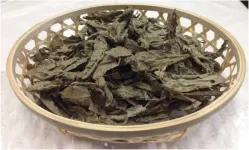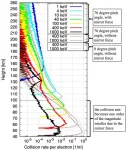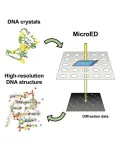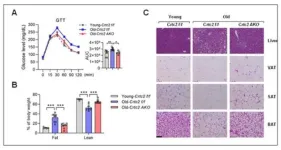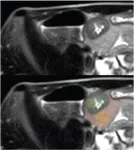(Press-News.org) Between 7% and 15% of people in North America, between 5% and 9% of people in Europe, and between 1% and 5% of people in Asia suffer from kidney stones. Common symptoms are severe pain, nausea, vomiting, fever, chills, and bloody urine. But kidney stones don’t just reduce the quality of life: in the long run, they may lead to infections, swollen kidneys (hydronephrosis), renal insufficiency, and end-stage renal disease. Known risk factors for developing kidney stones include being an adult male, obesity, chronic diarrhea, dehydration, and having inflammatory bowel disease, diabetes, or gout.
Now, a study in Frontiers in Nutrition has shown for the first time that an elevated consumption of added sugars should probably be added to the list of risk factors for kidney stones. Added sugars occur in many processed foods, but are especially abundant in sugar-sweetened sodas, fruit drinks, candy, ice cream, cakes, and cookies.
“Ours is the first study to report an association between added sugar consumption and kidney stones,” said lead author Dr Shan Yin, a researcher at the Affiliated Hospital of North Sichuan Medical College, Nanchong, China. “It suggests that limiting added sugar intake may help to prevent the formation of kidney stones.”
National Health and Nutrition Examination Survey
Yin et al. analyzed epidemiological data on 28,303 adult women and men, collected between 2007 to 2018 within the US National Health and Nutrition Examination Survey (NHANES). Participants self-reported if they had a history of kidney stones. Each participant’s daily intake of added sugars was estimated from their recall of their most recent consumption of food and drinks, given twice: once in a face-to-face interview, and once in a telephone interview between three and 10 days later. For example, participants were asked if they had eaten syrups, honey, dextrose, fructose, or pure sugar during the past 24 hours.
Each participants also received a healthy eating index score (HEI-2015), which summarizes their diet in terms of the adequacy of beneficial diet components such as fruits, vegetables, and whole grains, and moderation of potentially harmful foods, for example refined grains, sodium, and saturated fats.
The researchers adjusted the odds of developing kidney stones per year during the trial for a range of explanatory factors. These included gender, age, race or ethnicity, relative income, BMI, HEI-2015 score, smoking status, and whether the participants had a history of diabetes.
At the start of the study, participants with a higher intake of added sugar tended to have a higher current prevalence of kidney stones, a lower HEI score, and a lower education level. The overall mean intake of added sugars was 272.1 calories per day, which corresponds to 13.2% of the total daily energy intake.
Positive association between added sugars and kidney stones
The researchers showed that after adjusting for these factors, the percentage of energy intake from added sugars was positively and consistently correlated with kidney stones. For example, participants whose intake of added sugars was among the 25% highest in the population had 39% greater odds of developing kidney stones over the course of the study.
Similarly, participants who derived more than 25% of their total energy from added sugars had a 88% greater odds than those who derived less than 5% of their total energy from added sugars.
The results also indicated that participants from ‘Other’ ethnicities – for example Native American or Asian people – had higher odds of developing kidney stones when exposed to greater-than-average amounts of added sugars than Mexican American, other Hispanic, non-Hispanic White, and non-Hispanic Black people. People with a greater Poverty-Income Ratio (PIR; ie, the ratio between their income and the federal poverty level) had greater odds of developing kidney stones when exposed to more added sugars than people at or slightly above poverty level.
Possibility of confounders
The mechanisms of the relation between consuming more added sugars and a greater risk of developing kidney stones is not yet known. Because this was an uncontrolled observational trial, it can’t yet be ruled out that unknown confounding factors might drive this association.
“Further studies are needed to explore the association between added sugar and various diseases or pathological conditions in detail,” cautioned Yin. “For example, what types of kidney stones are most associated with added sugar intake? How much should we reduce our consumption of added sugars to lower the risk of kidney stone formation? Nevertheless, our findings already offer valuable insights for decision-makers.”
END
Consuming added sugars may increase risk of kidney stones
Researchers have shown for the first time that a greater intake of added sugars is associated with a greater risk of kidney stones
2023-08-04
ELSE PRESS RELEASES FROM THIS DATE:
Tropical plant native to China reveals antiobesity potential
2023-08-04
Obesity, a major risk factor for various lifestyle diseases such as diabetes and hypertension has become widespread worldwide, inherently demanding innovative solutions to combat it.
A multi-institutional research group led by Associate Professor Akiko Kojima of the Graduate School of Human Life and Ecology at Osaka Metropolitan University, has made significant progress in the fight against obesity. The group had previously conducted a study on the effects of the extract of Mallotus furetianus (MFE), a tropical plant native to Hainan Island, China, on the prevention of fatty liver, but the antiobesity effects of MFE and its mechanisms had not been ...
Parasites of viruses drive superbug evolution
2023-08-04
In a study published today in Cell, one of the most prominent peer-reviewed scientific journals in the field of Biochemistry & Molecular Biology, scientists from the National University of Singapore (NUS) and Imperial College London have discovered a new way by which bacteria transmit their genes, enabling them to evolve much faster than previously understood. Led by Assistant Professor John Chen from the Department of Microbiology and Immunology and the Infectious Diseases Translational Research Programme at the NUS Yong Loo Lin School of Medicine (NUS Medicine), ...
Geomagnetic field protects Earth from electron showers
2023-08-04
Understanding the ionosphere high in the Earth's atmosphere is important due to its effects on communications systems, satellites and crucial chemical features including the ozone layer. New insights into the activity of high energy electrons have come from a simulation study led by geophysicist Yuto Katoh at Tohoku University, reported in the journal Earth, Planets and Space.
"Our results clarify the unexpected role of the geomagnetic field surrounding the Earth in protecting the atmosphere from high energy electrons," says Katoh.
The ionosphere is a wide region between roughly ...
Displaying the design of DNA
2023-08-04
Function and form are deeply intertwined in biology. Knowing how organisms grow, adapt and reproduce requires understanding their physical structures. Hence the transformative power of the microscope across the past four centuries of science.
Microscopy, or the field of microscope use, can now reveal the tiniest of structures through techniques such as microcrystal electron diffraction, or MicroED. Instead of passing light through a cell like an optical microscope, MicroED bombards crystalline samples with a stream of electrons to produce detailed information about their atomic configuration.
“The method was developed ...
Unveiling a new mechanism that accelerates aging of adipose tissues
2023-08-04
Korean researchers have unveiled a novel signaling pathway that fosters aging-related chronic metabolic disorders.
A research team led by Professor Jong Kyoung Kim from the Department of Life Sciences at POSTECH along with Professor Seung-Hoi Koo from the Division of Life Sciences at Korea University and principal researcher Geum-Sook Hwang from Korea Basic Science Institute (KBSI) announced the discovery of a new mechanism where BCAA metabolic pathway becomes impaired due to aging, resulting in dysfunctions of adipose cells and chronic metabolic disorders. The research findings were published in Nature Aging (IF=16.6) ...
Diagnosing pediatric Crohn disease with radiomic and clinical data
2023-08-04
Leesburg, VA, August 4, 2023—An accepted manuscript published in the American Journal of Roentgenology (AJR) found that deploying a radiomic-based model with T2-weighted MRI data could increase diagnostic accuracy for pediatric Crohn disease (CD).
Noting that ileal-wall radiomic features were strongly predictive of CD—and that model performance improved when ensembled with clinical data—“a radiomic machine learning model predicted CD diagnosis with better performance than two of three expert radiologists,” wrote corresponding author and AJR Pediatric Imaging Section Editor Jonathan R. Dillman, MD, MSc.
Dillman et al.’s manuscript ...
Childhood trauma may heighten subsequent risk of pregnancy complications
2023-08-04
Childhood trauma, such as abuse, emotional neglect, and exposure to domestic violence, may heighten a woman’s subsequent risk of pregnancy complications, and of giving birth to a low birthweight or premature baby, finds a pooled data analysis of the available evidence, published in the open access journal BMJ Open.
The risks of pregnancy related diabetes, high blood pressure, depression/anxiety and of giving birth to underweight and or premature babies may all be significantly higher, the analysis suggests.
While previously ...
Peppermint oil aromatherapy may ease pain severity after heart surgery
2023-08-04
The use of essential peppermint oil aromatherapy may ease pain severity after open heart surgery and enhance sleep quality as well, suggest the results of a small comparative clinical trial, published online in the journal BMJ Supportive & Palliative Care.
Heart surgery is a major procedure, necessitating the separation of the breastbone (sternum) as well as mechanical breathing support, both of which are associated with a high risk of severe pain, stress, and sleeplessness, note the researchers.
Effective pain relief allows patients to recover more quickly and may reduce the risk of postoperative complications, ...
Mortality gap exists in 3,110 counties, 5 racial-ethnic groups, 19 causes, 20 years
2023-08-04
SEATTLE, Wash. August 3, 2023 – An analysis of 19 causes of death in the United States revealed persistent disparities and a familiar pattern across five racial-ethnic groups and 3,110 counties from 2000 to 2019. That’s according to the most comprehensive peer-reviewed research published today in The Lancet.
The mortality rates among American Indian or Alaska Native (AIAN) and Black populations were substantially higher than among White populations nationally and in most counties. For example, mortality was higher among the AIAN population than the White population in nearly all counties for skin and ...
Walking 25 mins/day enough to counter physical impact of bedrest on older hospital patients
2023-08-04
As little as 25 minutes a day of slow walking seems to be enough to counter the detrimental physical effects of bedrest on older hospital patients, finds a pooled data analysis of the available evidence, published online in the British Journal of Sports Medicine.
And for optimal improvements in physical function, around 50 mins/day of slow walking or around 40 mins of combined physical activities, such as 20 mins of resistance bands with around 20 mins of aerobic activity, are the most effective, the analysis indicates.
But there may be a threshold effect, with no clear benefit for ‘doses’ of more than 90 mins/day ...
LAST 30 PRESS RELEASES:
Tracing the quick synthesis of an industrially important catalyst
New software sheds light on cancer’s hidden genetic networks
UT Health San Antonio awarded $3 million in CPRIT grants to bolster cancer research and prevention efforts in South Texas
Third symposium spotlights global challenge of new contaminants in China’s fight against pollution
From straw to soil harmony: International team reveals how biochar supercharges carbon-smart farming
Myeloma: How AI is redrawing the map of cancer care
Manhattan E. Charurat, Ph.D., MHS invested as the Homer and Martha Gudelsky Distinguished Professor in Medicine at the University of Maryland School of Medicine
Insilico Medicine’s Pharma.AI Q4 Winter Launch Recap: Revolutionizing drug discovery with cutting-edge AI innovations, accelerating the path to pharmaceutical superintelligence
Nanoplastics have diet-dependent impacts on digestive system health
Brain neuron death occurs throughout life and increases with age, a natural human protein drug may halt neuron death in Alzheimer’s disease
SPIE and CLP announce the recipients of the 2025 Advanced Photonics Young Innovator Award
Lessons from the Caldor Fire’s Christmas Valley ‘Miracle’
Ant societies rose by trading individual protection for collective power
Research reveals how ancient viral DNA shapes early embryonic development
A molecular gatekeeper that controls protein synthesis
New ‘cloaking device’ concept to shield sensitive tech from magnetic fields
Researchers show impact of mountain building and climate change on alpine biodiversity
Study models the transition from Neanderthals to modern humans in Europe
University of Phoenix College of Doctoral Studies releases white paper on AI-driven skilling to reduce burnout and restore worker autonomy
AIs fail at the game of visual “telephone”
The levers for a sustainable food system
Potential changes in US homelessness by ending federal support for housing first programs
Vulnerability of large language models to prompt injection when providing medical advice
Researchers develop new system for high-energy-density, long-life, multi-electron transfer bromine-based flow batteries
Ending federal support for housing first programs could increase U.S. homelessness by 5% in one year, new JAMA study finds
New research uncovers molecular ‘safety switch’ shielding cancers from immune attack
Bacteria resisting viral infection can still sink carbon to ocean floor
Younger biological age may increase depression risk in older women during COVID-19
Bharat Innovates 2026 National Basecamp Showcases India’s Most Promising Deep-Tech Ventures
Here’s what determines whether your income level rises or falls
[Press-News.org] Consuming added sugars may increase risk of kidney stonesResearchers have shown for the first time that a greater intake of added sugars is associated with a greater risk of kidney stones
